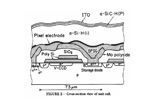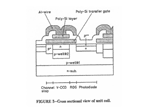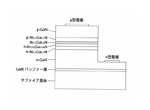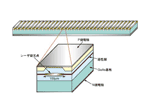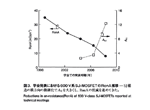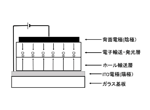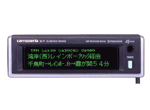Discrete Semiconductor Devices, etc.
1990s
1990: Development of first CCD sensor for HDTV having two million pixels per inch (Sony, Toshiba, and Matsushita)
Over 20 years, CCD image sensors evolved until the pixel size had been reduced by a hundredfold while maintaining pixel sensitivity. Various technologies were created, including on-chip color filters, on-chip microlenses, and tungsten light-shields, and made the development of an image sensor for application to HDTV camcorders possible. Twelve-million-pixel CCD image sensors appeared in 2010.
1993: Release of the world’s first commercial indium-gallium-nitride/gallium-nitride blue LED with high brightness (Nichia Corporation)
In December 1993, Nichia succeeded in developing a high-brightness blue LED having a luminous efficiency of 2.7% (100 times as efficient as previous blue LEDs). The device was a double-heterostructure LED fabricated of gallium-nitride and indium-gallium-nitride single-crystal thin film, formed by using the two-flow metal-organic chemical vapor deposition (MOCVD) technology invented by Shuji Nakamura of Nichia, and p-type gallium-nitride crystal, formed by thermal annealing. Nichia was the first company in the world to release an LED producing blue light with a wavelength of 450 nm at a luminous intensity of or above 1 cd.
1995: Development of a 650-nm-band aluminum-gallium-indium-phosphide-based laser for DVD players (Matsushita, Toshiba, Sharp, and Sony)
In 1985, NEC, Sony, and Toshiba achieved continuous oscillation of an infrared laser at room temperature. The laser was formed of aluminum-gallium-indium-phosphide-based materials, which can be epitaxially grown on a gallium-arsenide substrate. This marked the start of 650-nm-band laser development. Manufacturers developed lasers of this type for practical use – for example, the HDSA (highly doped saturable absorbing) structure laser from Matsushita – and lasers of this type were used as the light sources in DVD players for home use, which first arrived on the market in 1996.
1997: Mass production of a large-output laser diode for in-vehicle LIDAR (Denso Corporation)
Denso developed the aluminum-gallium-arsenide/gallium-arsenide large-output semiconductor laser with a broad stripe structure (light-emission wavelength: 360 μm). This device was used in LIDAR (light detection and ranging) units installed in the adaptive cruise control (ACC) systems of automobiles released in 1997.
1997: Invention of the super-junction MOSFET (Fuji Electric Co., Ltd.)
Tatsuhiko Fujihira of Fuji Electric and others devised a vertical MOSFET using the super-junction (SJ) structure, in which the drift layer is comprised of alternating n- and p-type layers instead of a low-concentration n-type layer. This structure ensures a high breakdown voltage even when the concentration of the n-type impurity is increased, which reduces the on-resistance. The super-junction structure thus became the major structure used for power MOSFETs with high breakdown voltage (e.g., for use in power supplies).
1997: Commercialization of the world's first Organic LED flat panel display (Pioneer)
Pioneer is the first company in the world to use an Organic LED (OLED) dot matrix display for indicators, and launched the GD-F1, an FM teletext multiplex receiver for car use. The display has a passive matrix structure with a monochromatic green color, 256 x 64 pixels, display area of 94.7 mm x 21.1 mm, and a pixel size of 0.32 mm x 0.29 mm. It has realized a brightness of 100cd/m² and an element life of over 10,000 hours.


